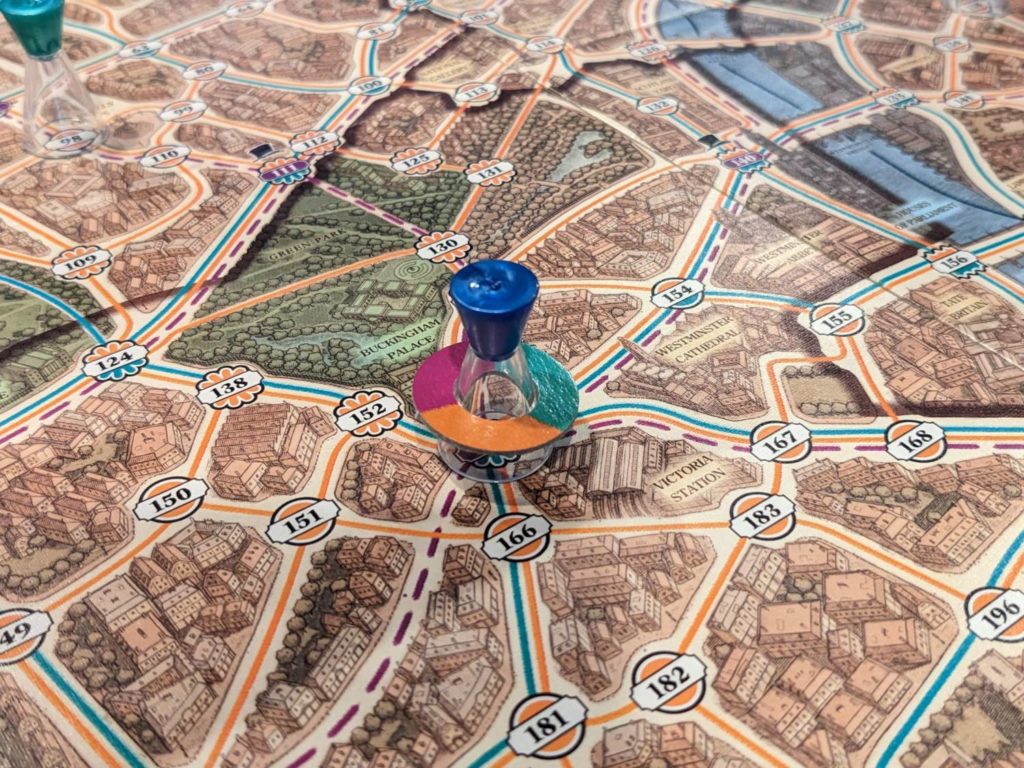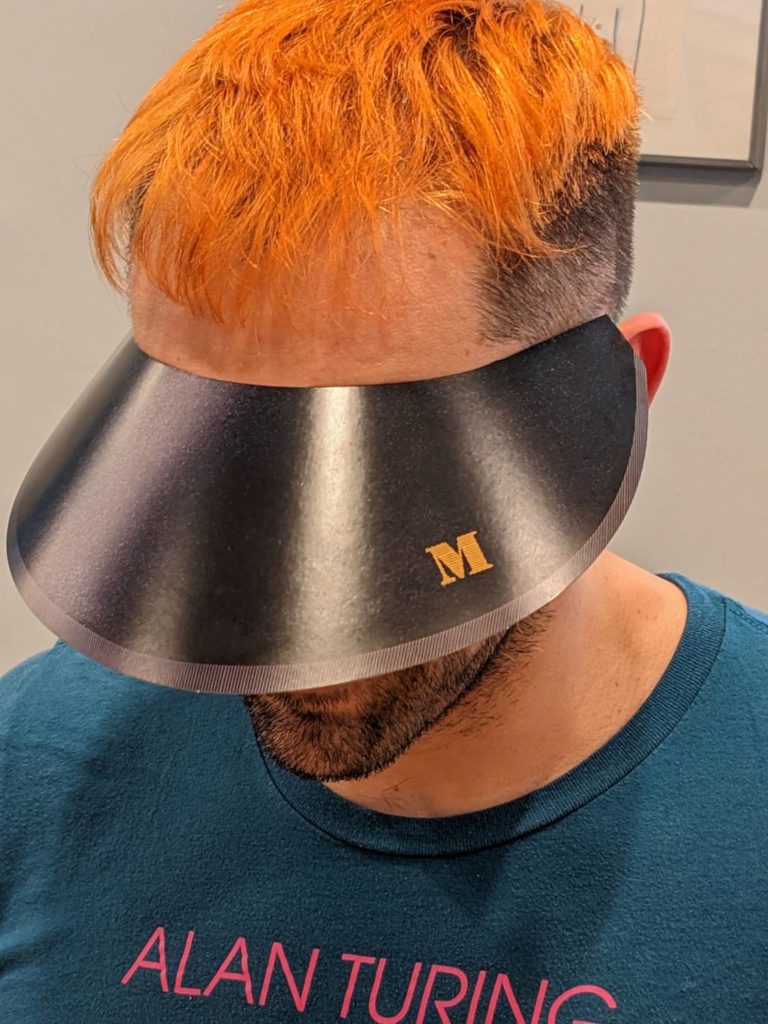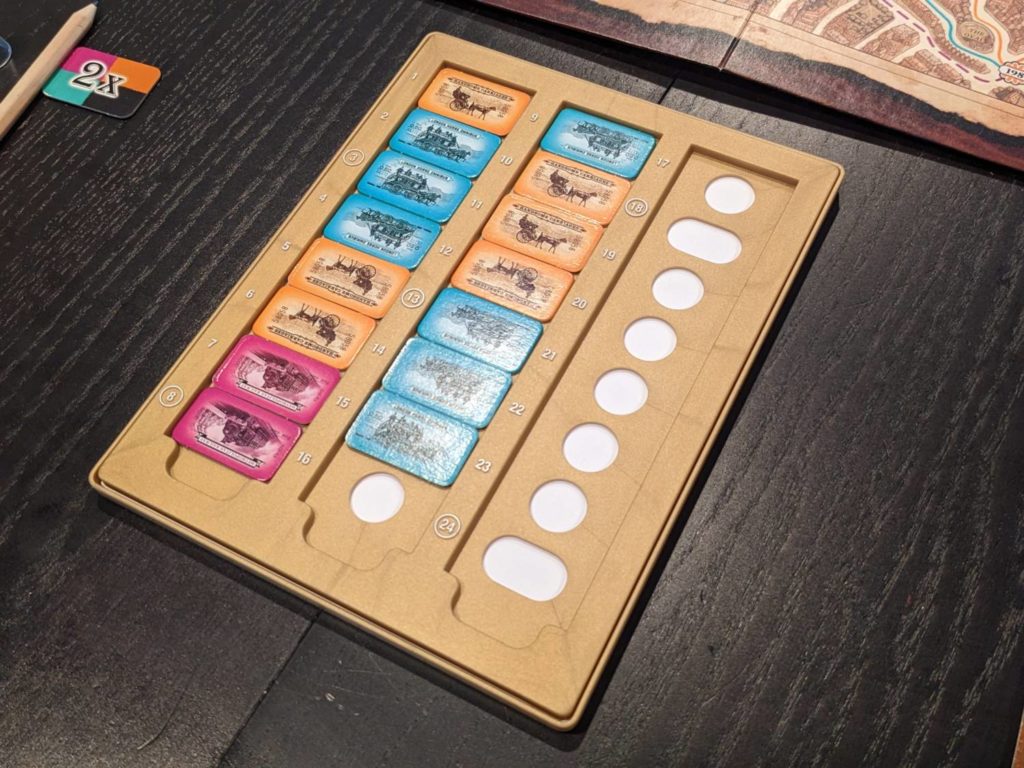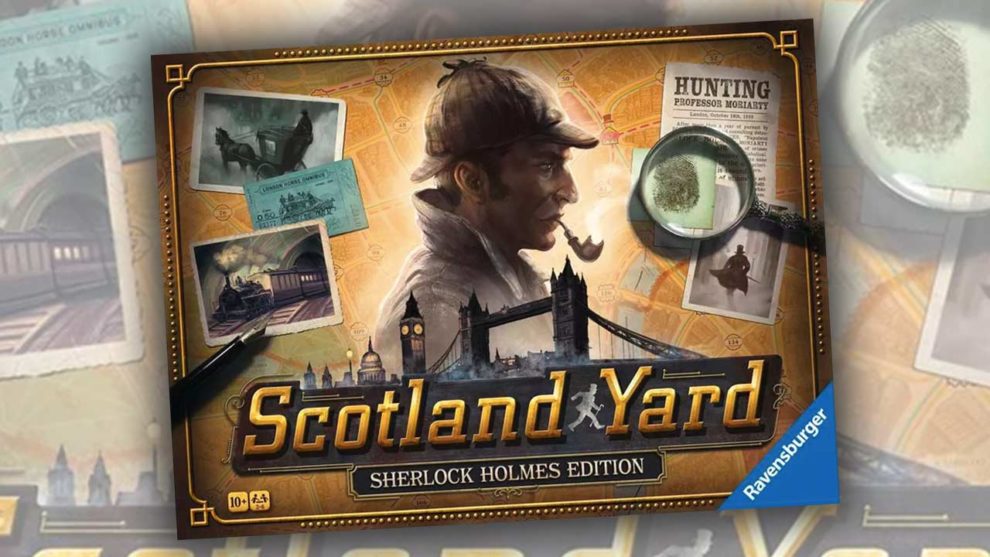Disclosure: Meeple Mountain received a free copy of this product in exchange for an honest, unbiased review. This review is not intended to be an endorsement.
“SCOTLAND YARD BABY!!!”
My brother and I were texting about an upcoming family beach trip a few years ago; he had secured an updated copy of Scotland Yard at a toy store and he was going to bring it to the beach.
We love Scotland Yard. We played it a bunch as kids with our family and other kids in the neighborhood. The fight was always the same, because everyone knew that playing as Mr. X, the game’s bad guy in the one-versus-many hidden movement experience, was the most fun.
Mr. X had a little notepad that was covered by a grid. This grid had a few callout spaces that required Mr. X to appear on the board from time to time, aiding the detectives as they used their limited set of tickets to move around London trying to catch Mr. X.
We played Scotland Yard only once during that beach trip, but it was a blast. It’s more accurate to say that it was a blast for my brother and I to play; our extended family was less enamored.
“Playing as a detective is kinda boring, bro.”
“Jeez, this game is long. Mr. X has eight more turns?”
Someone always wants to drop the logic bit into the proceedings, too. “How is it that the cops only have so many tickets to get around the board? Wouldn’t they have access to a police car or something? Are you really saying that the cops can only afford to take the subway like four times???”
OK, OK, I hear you. Even I had to admit that while Scotland Yard is still my favorite hidden movement game, it has its flaws. When Ravensburger announced a new take on the game, Scotland Yard: Sherlock Holmes Edition, I was intrigued. I was first thankful that the core game hasn’t been changed and is available as an option in this new package.
But, a new format, you say? Let’s give this a spin!

Professor Moriarty
Scotland Yard is a 40-year-old design and I only played the original version again once for the purposes of this review.
For me, it still works, but it has all of the same issues noted above. The most striking thing for me is the playtime; under the lens of a modern gaming experience, the original Scotland Yard is a bit slow, particularly with new players or those who are overly collaborative in trying to suss out the location of Mr. X.
Ahh, about that Mr. X thing: the only changes that were made to the original design for the new box are cosmetic. In the new version, all of the characters are actual characters with actual names from the Sherlock Holmes universe. The five characters available are Sherlock Holmes, Mycroft Holmes (Sherlock’s brother), Dr. Watson, Irene Adler, and Inspector Lestrade.
Also gone is Mr. X! In his place is longtime Holmes nemesis Professor Moriarty, who does look quite dastardly in this new version. Otherwise, the base game is the same.
The new version of Scotland Yard, Scotland Yard: Sherlock Holmes Edition, is what we’ll talk through here.
The game is mostly the same: 1-4 players take on the detective roles, and their task over the course of 16 turns is to catch Moriarty, a role taken on by a single player who still moves around the 200-station board in secret. Each turn, Moriarty writes down their current station, covering that station number on their notepad with the ticket matching the type of transportation they used to get there.
All players use the same methods to navigate the board—carriage (taxi in the original game, so yellow lines), tram (bus / green lines), or underground (pink lines in the original game, purple lines in the updated game). Moriarty also has access to the Thames Ferry, which requires the use of his special black tickets. Moriarty still has access to the “double move” tokens, which allow for two moves on a single turn to help evade the authorities.
The difference in movement: detectives have a small number of tickets to move, whereas Moriarty has access to unlimited amounts of tickets. That means Moriarty could use the underground all game long, but the detectives only have a small number of underground tickets to burn during the game.
If Moriarty is still a free man after 16 turns, Moriarty wins. Moriarty also wins if the detectives find themselves in spaces where they can’t move because they are out of matching tickets. (As with the original game, each station calls out which types of tickets are allowed for movement.)

So, What’s Really New Here?
The first thing that I noticed in my plays is the run time. Scotland Yard: Sherlock Holmes Edition is definitely shorter than the original, with a maximum 16 turns in the new version and as many as 22 turns in the original. That usually made the game last about an hour; the original game—including that beach game with my brother—takes a lot longer than that in the wrong hands.
The next thing that feels different: playing as the detectives. Even as a staunch defender of the original game, I will agree that playing on the right side of the law is mostly a spreadsheet game in the original. How can we move our four nameless detectives in such a way that we cut off all available options? I love the logic puzzle, but the detectives are completely devoid of any personality.
In the new version of Scotland Yard, you have Sherlock Holmes and his team. It’s a modern-day board game, so obviously the detectives have to have names and powers; the disappointing part of this is that the powers are really just “powers.”
I use the quotations because each player can only use their power once, maybe twice, in a game, and those powers are honestly quite weak.
Sherlock Holmes gets the Manhunt power; he can spend his one-time power token to force Moriarty to tell the detectives where he currently is, based on the board’s four quadrants. It’s easily the best of the detective powers in the game, which is saying something.
Watson’s power (“Interrogation”) is so situationally specific that one wonders if you can ever make that work well. Mycroft Holmes? “Searching for Clues”, which requires Moriarty to tell everyone where they were two turns ago.
I mean, what???
So, the inspector powers are only OK. Moriarty, though? Wow!
Moriarty gets all of the powers of the original game: black tickets and double move tickets. In this new version of the game, Moriarty starts with only one black ticket (used for the ferry or for covering up the method used to travel on that turn) and one double-move ticket to take two turns in a row. Moriarty can get more of these items by traveling to one of his dozen-or-so new “secret hideout” spaces.

The Moriarty player also gets a visor!
Yes, Moriarty even gets to basically use a costume to hide his eyes while staring at the board! This visor is actually pretty funny, but it’s a requirement—in order to plan, Moriarty really needs to be able to shield their eyes from other players. It’s a flimsy piece of cardboard that can be tied onto the back of the Moriarty player’s head, but it is so, so smooth!
But wait, there’s more! Moriarty has even more he can do at those hideouts. “Deep Dive” allows Moriarty to not reveal his location on the third, eighth, or thirteenth turn as in the base game and this updated version. Instead, Moriarty only has to announce that he is currently at one of the hideout spaces. In addition, Moriarty gets three “Crime Scene” cards, full of locations that can be visited to commit crimes. If Moriarty completes all three of the Crime Scene cards, even before turn 16, they win the game immediately.
And, the biggest power of them all: once per game, Moriarty can use a hot air balloon to trigger the “Escape” action. This means that while at a hideout, Moriarty can use Escape to move to one of the two stations on a randomly-drawn start tile. When cornered and at a station, this ability is absolutely massive; in essence, Moriarty can teleport to another location. This does require Moriarty to reveal where he will be on his next turn, meaning that if he lands somewhere within two spaces of another detective, he will definitely be caught—
JUSTIN, THE RULES SEEM TO INDICATE THAT MORIARTY COULD USE THE ESCAPE and A 2X TOKEN TO BOTH TAKE OFF THEN LAND ON THE SAME TURN. DOESN’T THAT FEEL…WHAT’S THAT TERM YOU ALWAYS USE…”OP”???

Flip the Table
On my second play of Scotland Yard: Sherlock Holmes Edition, it happened.
Two of us were playing as the detectives, which means we had the ability to use two “bobbies” that gave us room to operate four total detectives on the map. There were some fun swings, as we used the Manhunt power to identify which quadrant Moriarty was in; it was the southeast quadrant, so we got our four detective movers in position.
We used simple deduction to narrow the list of possible locations. Watson used his Interrogation skill and guessed “river”; we got lucky and came up with a positive hit, meaning that we had narrowed Moriarty’s position to one of two stations. We were close enough that we knew we had a chance.
Two turns later, it happened: Moriarty got to a hideout and used the Escape skill to teleport to a spot in the northwest corner of the map. It was the tenth turn of the game; with six turns to go, there was no way we were going to catch Moriarty, so the detectives conceded.
Then my fellow human detective absolutely lost it.
“If this was a poker table, I would have flipped it over, for sure,” he said. “To slowly close the net, use deduction, track the types of tickets Moriarty was using, use our own detective powers, then for that to happen…it’s pretty deflating.” (I think he used “deflate” to emphasize how much he hates balloons, but at that point, I didn’t want to stop the flow.)
I sat back in my chair and I had to agree—the Escape option is just too powerful. Sure, it can only be used once per game, and I admitted to the Moriarty player that the timing of this single use was essentially perfect; we had one detective one space away when it was used.
But I imagined the use of it in real life, almost like it was a movie—it was as if the author of the story wanted Moriarty to get away, like he was cackling in the balloon’s cockpit as he rose into the sky yelling “Gotcha, coppers! BWAHAHAHAHAHA!!!”
So, as a movie moment, the Escape option is fantastic. Hell, just being Moriarty almost all game long seemed like it was fantastic.
But that’s not going to feel good if you are playing as the detectives.
All of this makes Scotland Yard: Sherlock Holmes Edition a tricky proposition. I love many elements of the new design, but some of them don’t quite feel right. Some light asymmetry to the detective powers feels right; forcing Mr. X/Moriarty to use the hideouts to gather more of those special black and 2X tickets also feels right on. I also love the shorter playtime.
But this is still a game that plays best if you are the bad guy. The Crime Scene cards give Moriarty an option to try and rush the ending, and that would almost certainly be the move if they are dealt a series of cards that feature locations in close proximity to one another.
The Deep Dive and Escape powers feel imbalanced; the fact that Moriarty can do the Escape action then immediately take another turn is absolutely broken, even as a once-per-game power. I would house rule the Escape option out of the game entirely.
One thing I would be open to: playing the base Scotland Yard game with the detective powers, while Moriarty gets access to the limited starting special tickets and the Deep Dive power. That feels roughly even to me. Another idea: letting players combine their detective powers to use on the same turn (at present, the game only allows one detective to use their special power each round).
So, everything I need is here to come up with a perfect balance. I just need to find the best way to parse it out. I love that these new options are here, and for new players, I think they will work out the best way to allow players to attack the game. The main negative no matter what format you are playing?
The board.
The map of “Modern London” (the state of the city in 1895) is a bland-looking, historically accurate view of the city; the main problem is finding the numbers of each station. The layout takes some getting used to, much like the original game; I was hoping for a more intuitive layout. As it is, it’s too difficult sometimes for players to pick up where they can legally move with each ticket type, or when looking for a specific number. Even using a number system that aligned with the quadrants would have helped here, and not lost anything in the spirit of the original game.

The Solution?
If you are playing as Moriarty, Scotland Yard: Sherlock Holmes Edition is one of my favorite experiences of the year. You get a cool visor, you get all the great toys, you get to watch as the detectives fumble around searching for you, and you have a variety of ways to try and win the game. It’s a blast, full stop.
If you are playing as a detective? Well…
I prefer playing as a detective using the base game rules; even with the personalities and player powers in the new version, I still prefer the old ways of playing Scotland Yard. While I think I always want to play with four human detectives, I didn’t mind the lower detective player counts while going through this experience. It’s fun to collaborate on the whereabouts of Moriarty, and planning out turns is still a good time.
But when you are playing as a detective, I actually think the new version is harder than the original, particularly when playing against a seasoned Moriarty player. (I have not seen this yet, because usually I am the most seasoned Scotland Yard player at the table.)
Moriarty’s tool set is incredible. It’s entirely possible that Moriarty never appears on the board during the entire game in the new version. If you don’t house-rule it out of the game, the Escape power is really something else. 16 turns is not a lot of time, and if Moriarty starts on a part of the map where there are no other detectives, the detectives will spend half the game just hoping to get close enough to be a threat.
Scotland Yard is still great. But the experience really swings based on who you are playing. For veterans of the game, this version is worth trying just to see where you land on the updated rules, and the game’s MSRP is pretty solid for what is in the box.












Add Comment